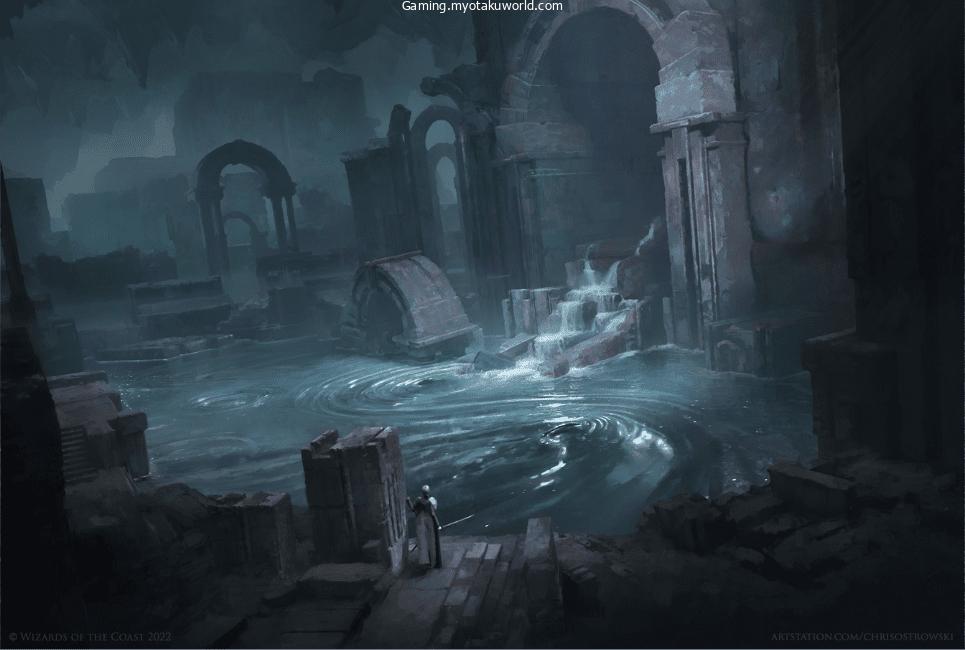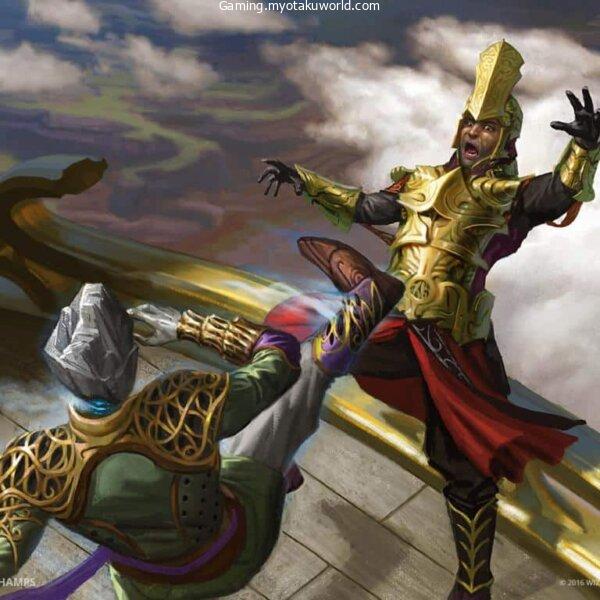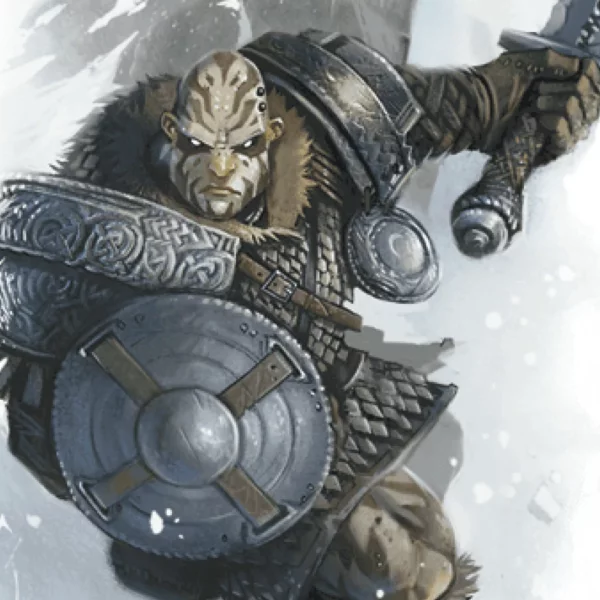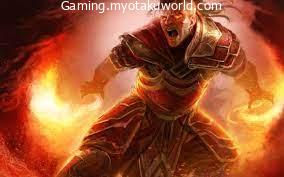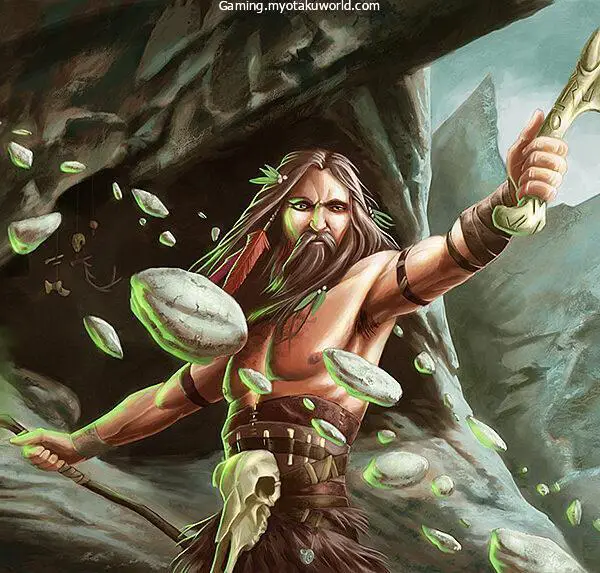A group of goblins are looking for scraps of meat and metal in a ruined dungeon when they see a group of adventurers in a narrow hallway.
They try to sneak up on them, but the goblins see them. They aren’t scared, though, so they go ahead with their plan and rush towards them. The Wizard in the group says some magic words and waves his hands, and his staff starts to glow.
The goblins stop dead in their tracks. It looks like the ground is hard for them to walk on. When they look down, they see something oily on it. They try to stay balanced, but they fail and fall down.
The adventurers seize the chance and quickly defeat the goblins who are now helpless. What the Wizard did shows the power of the level one spell Grease.
It can make the ground too slippery for someone to stand on, which can cause them to slip and fall. Also, it makes the ground hard to walk on, so anyone who tries to walk on it moves slower than usual.
Some players say that Grease is their favourite level one spell. If you want to know why, this Grease 5e Guide can tell you about its strengths and weaknesses.
What is Grease in D&D 5e?
Grease covers the ground in a 10-foot square around a point in range and makes it hard to walk on for the duration.
When the grease shows up, every creature in the area must make a Dexterity saving throw or fall down. Any creature that moves into the area or ends its turn there must also pass a Dexterity saving throw or fall down.
Below are the crucial details about the Grease spell in D&D 5e.
- Grease
- Level one conjuration
- Casting Time: one action
- Range: 60 feet
- Components: V, S, M (a bit of pork rind or butter)
- Duration: One minute
How to Use Grease in D&D 5e ?

Before you can use the Grease spell to make an enemy slip and fall, you must first meet all of its requirements. Here’s what they are:
- You must know this spell or have it prepared. Various classes, like the Bard or Sorcerer, know spells while others, like the Wizard and Cleric, prepare them from their spell book.
- You must have at least a level one spell slot. Grease is a level one spell, so you need at least an available level one spell slot to cast it. You can also use a higher-level spell slot, but it would not change the spell’s effects.
- You must use an action to cast it. This rule especially applies during combat.
- You must be able to talk. The Grease spell needs the verbal component, i.e., you need to say magical words in an audible voice.
- You must be able to use your arms. The Grease spell needs the somatic component, i.e., you need to wave your arms around.
- You must have a bit of pork rind or butter. It is the Grease spell’s material component. However, if you have a spellcasting focus, like a staff, you can use it instead.
You can use the Grease spell if you have checked all the requirements and found that they are all met. Do the steps below as you do this.
- Choose a point within 60 ft. of you. A 10-foot square centered on that point becomes affected by the Grease spell.
After you choose where you want the grease to show up, the spell will work right away. In the next section, you’ll learn how the Grease spell works.
How Does Grease Work in D&D 5e?
After you cast it, a 10-foot square of slick grease comes out of the spot you chose. For one minute, the following effects happen: (ten rounds if you cast this spell during combat).
- The 10-foot square of ground becomes difficult terrain. In D&D rules, walking over difficult terrain takes up twice the standard movement speed. For example, walking over ten feet of difficult terrain would need 20 ft. of movement speed.
- Creatures make a Dexterity saving throw when they are:
- Standing within the spell’s area.
- Entering the spell’s area.
- Ending their turn in the spell’s area.
- Compare the Dexterity saving throw and your Spell Save DC. Spell Save DCs depend on your class; for example, an Artificer’s Spell Save DC is 8 + their proficiency bonus + their Intelligence modifier. They succeed if the Dexterity saving throw is equal to or greater than the Spell Save DC. Otherwise, they fail their Dexterity saving throw.
- If the target fails in their Dexterity saving throw, they become prone. Being prone means that they suffer from the “Prone” condition as explained in the D&D rules. The effects below detail the penalties prone creatures get.
- Prone creatures can only crawl until they stand up. Crawling takes up an extra foot of movement. For example, crawling over ten ft. would need 20 ft. of movement speed. However, crawling over ten feet of difficult terrain needs 30 ft. of movement speed.
- Prone creatures can stand up in exchange for half their movement speed. For example, if the prone creature has 30 ft. of movement, they use 15 ft. of it to stand up.
- Prone creatures have a disadvantage on their attack rolls. Having a disadvantage on the attack rolls means they roll two d20s and pick the lower result.
- If someone five ft. near the prone creature attacks them, the attacker gains an advantage in their attack roll. As opposed to having a disadvantage, an advantage means they roll two d20s and pick the higher result.
- If someone attacks the prone creature but is not within five ft. of them, they gain a disadvantage in their attack roll. For example, someone with a bow gets a disadvantage in their attack roll if that person attacks a prone creature 20 ft. away from them.
The Grease spell is pretty easy to understand, but some players find it hard to understand the rules for the “Prone” state. Also, it can be hard to figure out how the effects of crawling and difficult terrain work together.
So, in the next section, I’ll show you a demonstration of how the spell works in combat.
Example Scenario for Using Grease in D&D 5e

Welcome to Arthur’s Lab, where bandits fall down a slippery slope into a world of pain and suffering for the sake of science. This time, we’ll look at the level one conjuration spell “Grease.”
I had just done these experiments on the islands when I wrote my last guides. But since this is not a very big spell, we will go back to the lab for this demonstration.
Marshal the Half-Elf Wizard is helping us plan this battle, and he is ready to use the Grease spell. He also has a level 1 spell slot that he will use to cast the spell. Along with him are two thieves who joined us “willingly” for the cause. In this experiment, here are some important facts about Marshal and the Bandits:
- Marshal the Half-elf Wizard
- Armor Class: 15
- Intelligence modifier: +3
- Proficiency bonus: +4
- Spell Save DC: 8 + Intelligence modifier + proficiency bonus = 8 + 3 + 4 = 15
- Bandits
- Movement speed: 30 ft.
- Dexterity saving throw modifier: +2
- Attack Bonus: +3
Marshal Casts the Grease Spell
Marshal’s turn has come, and he uses a level one spell slot to cast the Grease spell. He can use a spell slot of a higher level, but the spell’s effects will be the same no matter what level it is.
He has to choose where the 10-foot square of grease from the spell will appear within 60 feet of him. He chooses the area shown below.
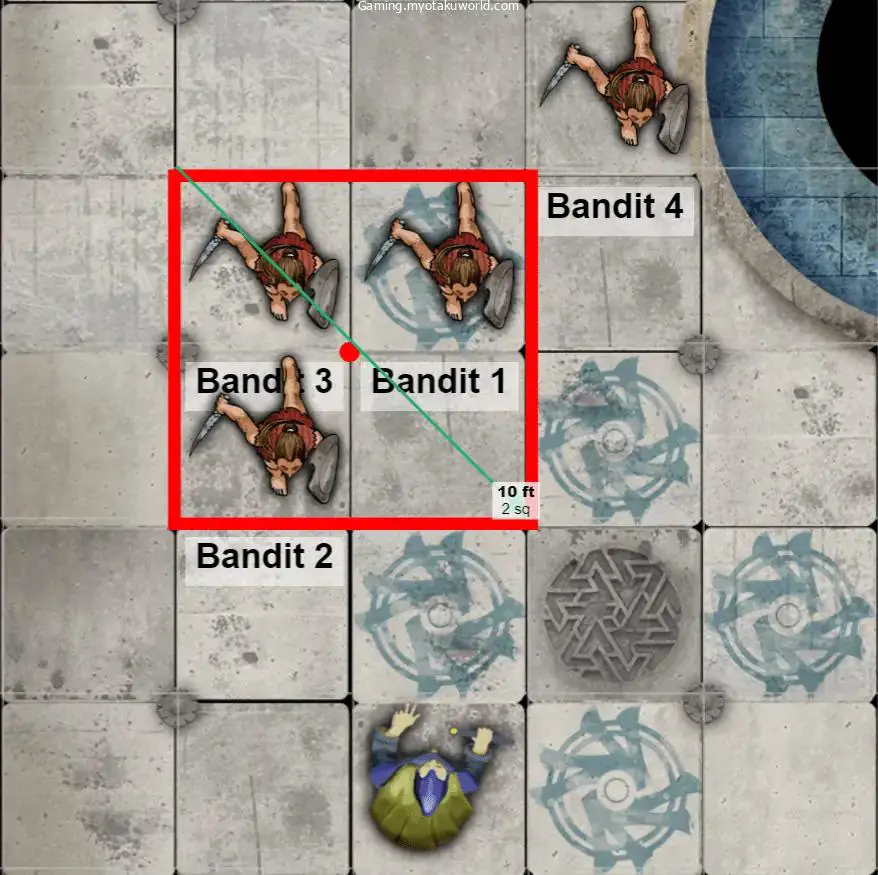
The spell takes effect right away, and a 10-foot-square area is covered with greasy oil. This slippery substance will stay there for one minute (or ten rounds of combat), making that area hard to move through.
Bandits 1, 2, and 3 must make a Dexterity saving throw against Marshal’s Spell Save DC of 15, or they will fall and become prone.
The Bandits Do a Dexterity Saving Throw for Grease
When Marshal cast the Grease spell, Bandits 1, 2, and 3 were inside its area of effect, so they must roll a d20 for a Dexterity saving throw or fall. Everyone has a +2 bonus to their Dexterity saving throw. Here are the results of what they did:
- Bandit n: d20 + Dexterity saving throw modifier = Dexterity saving throw
- Bandit 1: 12 + 2 = 14
- Bandit 2: 9 + 2 = 11
- Bandit 3: 14 + 2 = 16
The Dexterity saving throws of Bandits 1 and 2 fail because their results are lower than the Marshal’s Spell Save DC of 15. So, they fall and end up on their backs. This is called the “Prone” condition. The result for Bandit 3 is higher than the Spell Save DC for Marshal, so he stays standing.
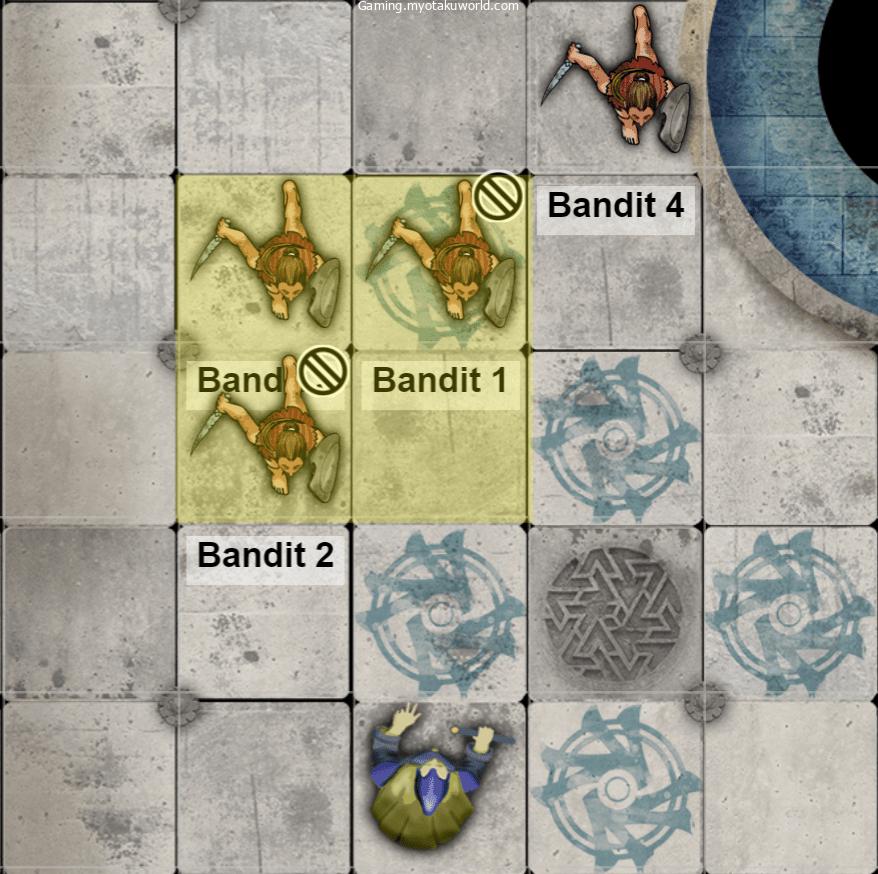
Bandit 1 Crawls Forward and Attacks Marshal
Bandit 1 fell because of the Grease spell. He can stand up or crawl by using his speed. He decides to move towards Marshal by crawling. Crawling costs an extra foot of movement, so if he wanted to move five feet forward by crawling, it would cost him ten feet of movement speed.
Moving over costs an extra foot of movement as well. So, if Bandit 1 moves five feet forward while in the area of the Grease spell, it will slow him down by 15 feet.
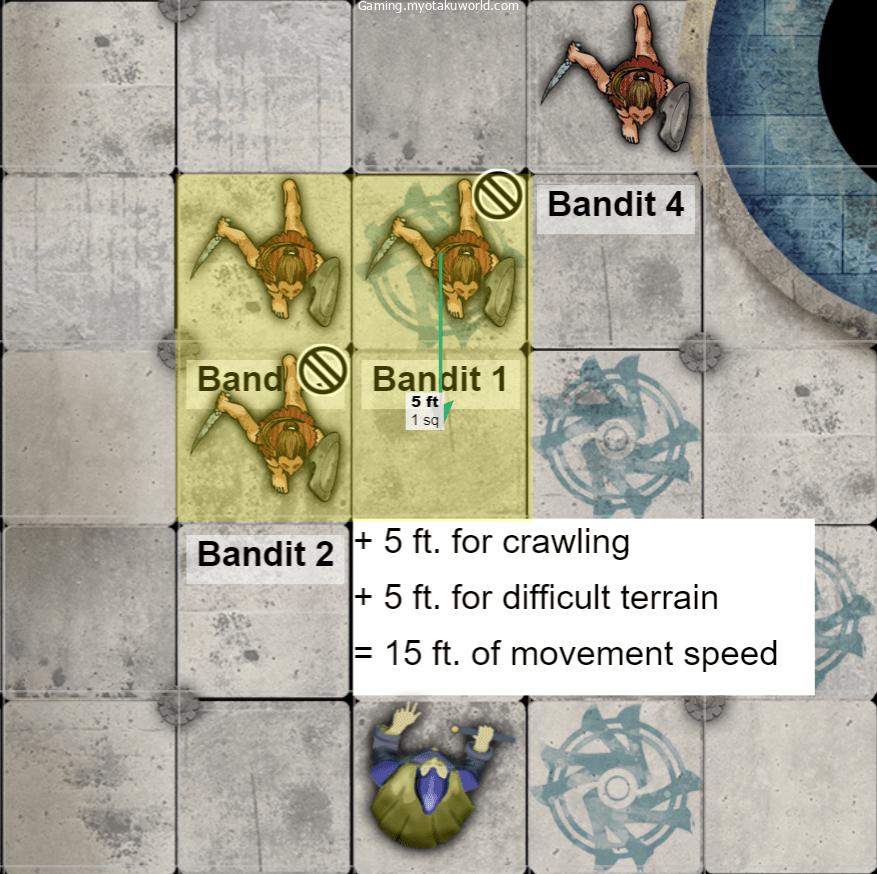
If he moves forward again, he is no longer walking over rough ground. He is still crawling, though. So, if he does this move, he will lose 10 feet of movement.
He can move 30 feet per turn. However, he can only move 15 feet per turn when crawling over rough terrain and 10 feet per turn when crawling forward. He can only move five feet faster now. He needs 15 feet of space to get up, so he stays down.
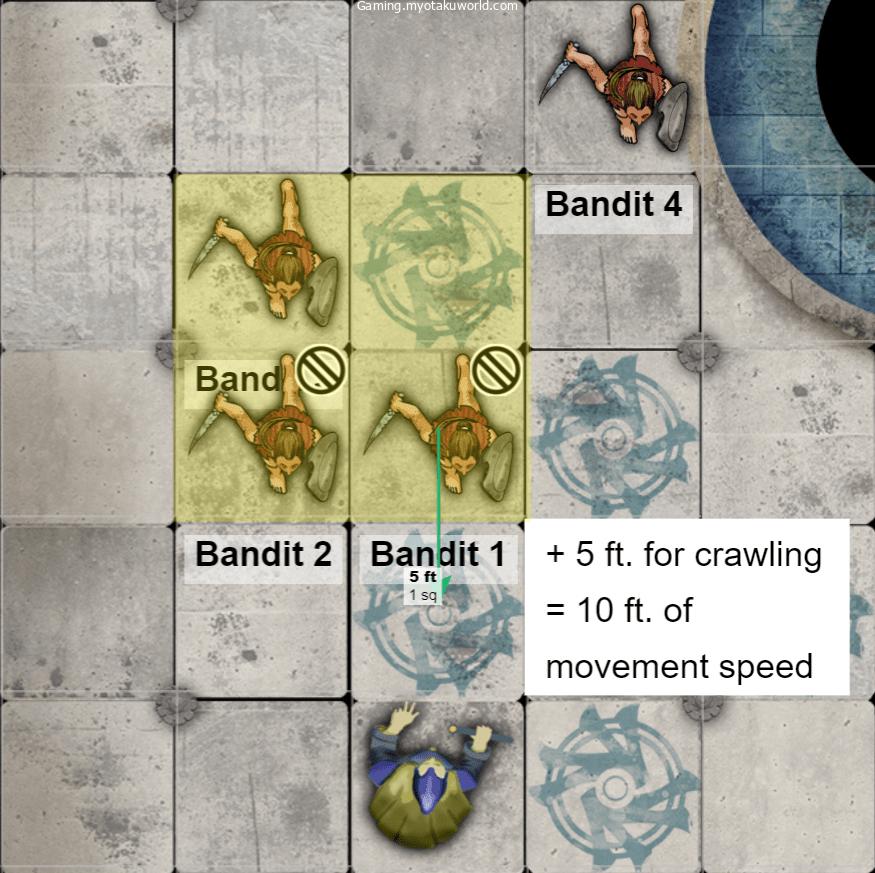
Then Bandit 1 tries to attack Marshal, but because he is on the ground, his attack roll is worse. So, he rolls two 20-sided dice and gets 17 and 5, so he chooses the lower number. Their attack roll gets a +3 attack bonus, so here’s how we figure out their attack roll:
- Attack roll = d20 + attack bonus
- Attack roll = 5 + 3
- Attack roll = 8
Marshal’s Armor Class is 15, meaning Bandit 1’s attack misses.
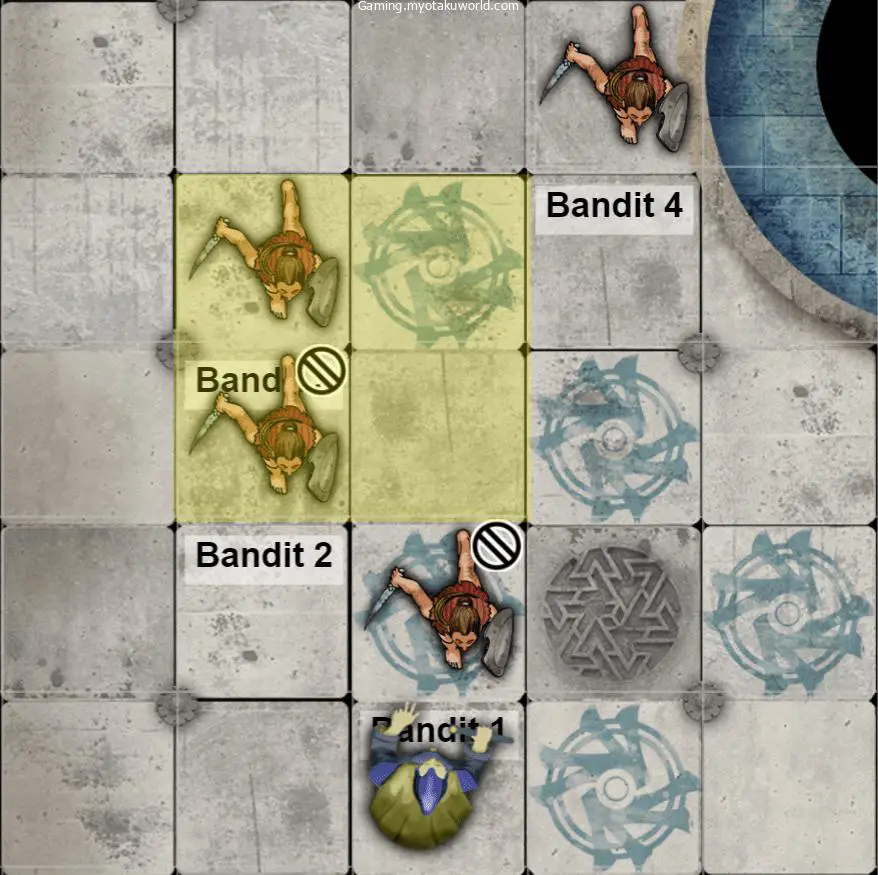
Bandit 2 Stands Up While on the Grease
Bandit 1’s turn is over, so it’s now Bandit 2’s turn. He decides to stand up since he is lying down. When a creature is prone, it costs half of its movement speed to get up. Bandit 2 has a movement speed of 30. So, getting up would require 15 feet of movement.
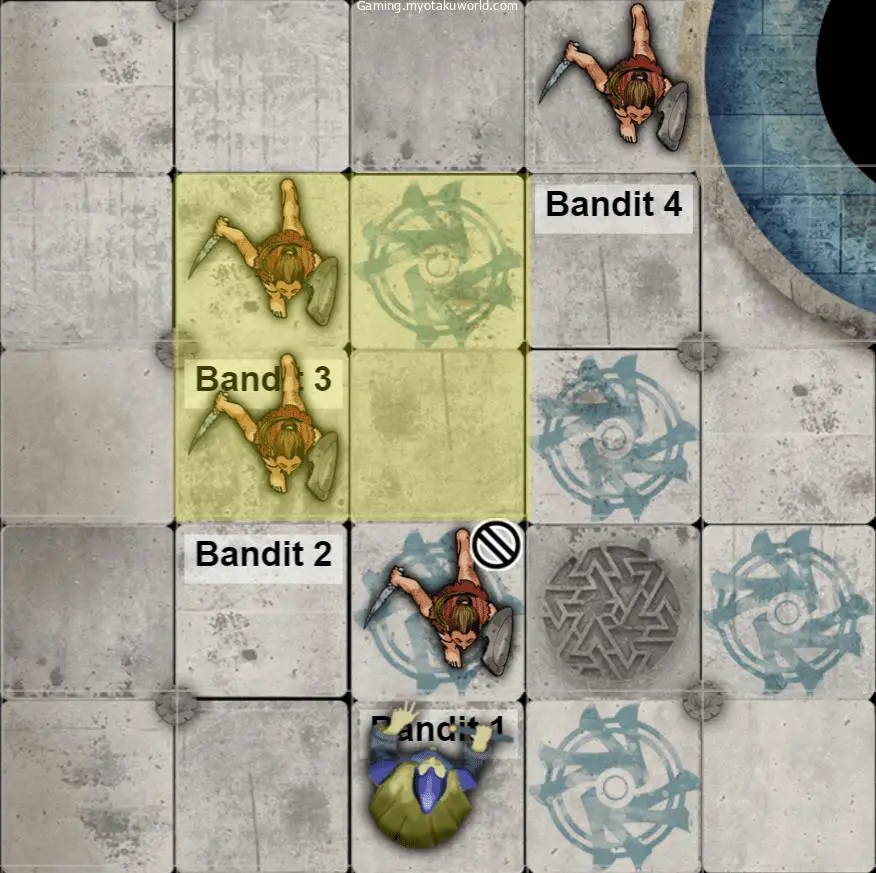
He still has 15 feet of movement speed after getting up. He moves to the left side of Marshal, which slows him down by 10 feet. At the end of his turn, he can move five feet faster.
Bandit 3 Ends His Turn on the Grease
Now it’s the turn of Bandit 3, who moves behind Bandit 1. He doesn’t have to stand up because his Dexterity saving throw was successful, which means he didn’t fall prone.
But the Grease spell turns the area into hard terrain, and since Bandit 3 is moving through it, it takes him twice as long to move as usual. So, it slows him down by 10 feet instead of 5 feet.
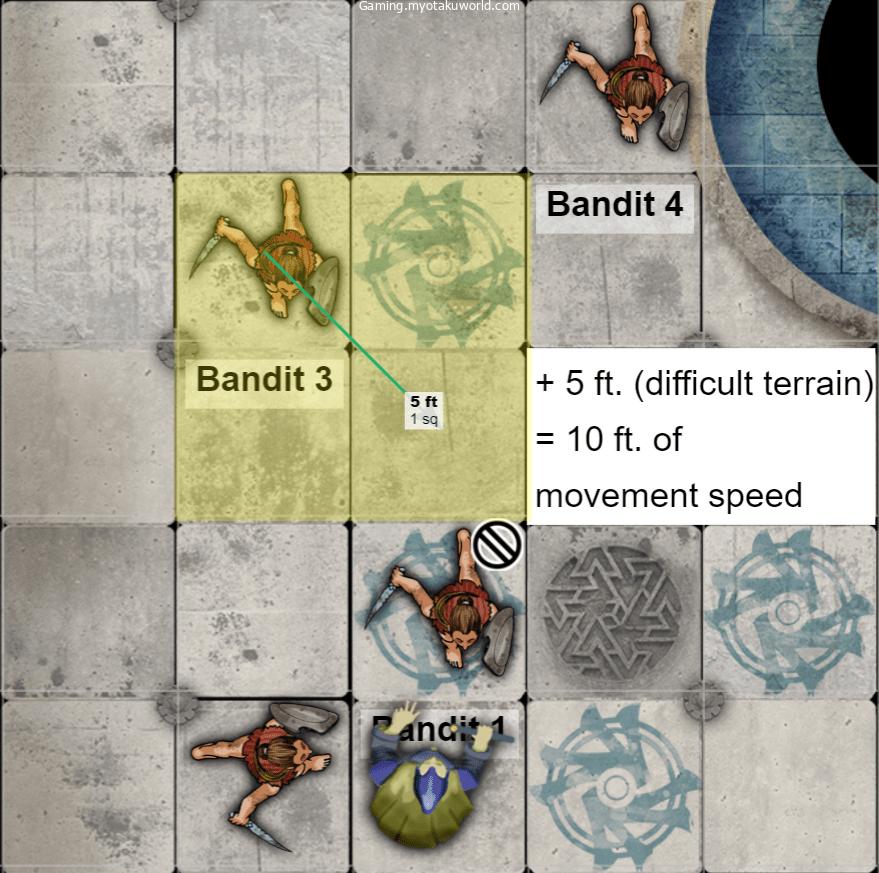
Then he decides that’s where his turn ends. According to the rules of the Grease spell, anyone who ends their turn on the area affected by the Grease spell must succeed on a Dexterity saving throw or fall prone. So, he rolls the dice for it and gets an 8. Here’s how we figure out his Dexterity saving throw:
- Dexterity saving throw = d20 + Dexterity saving throw modifier
- Dexterity saving throw = 8 + 2
- Dexterity saving throw = 10
Ten is lower than Marshal’s Spell Save DC of 15; therefore, Bandit 3 falls prone.
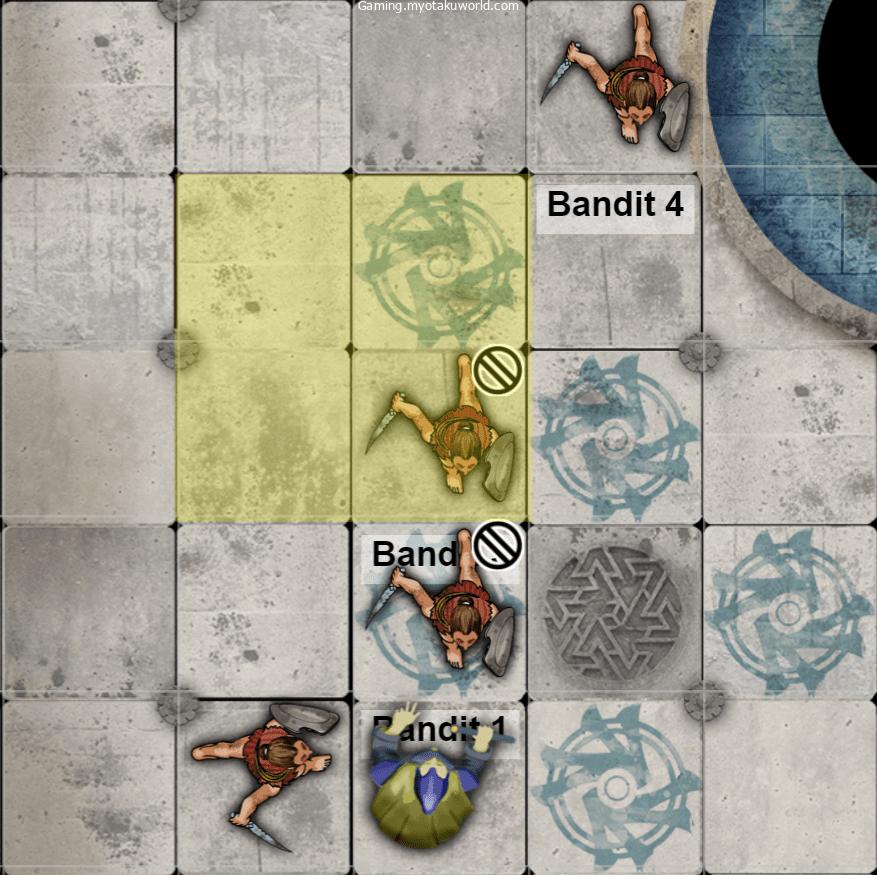
Bandit 4 Enters the Grease
Bandit 4’s turn comes up, and he decides to go into the area where the Grease spell is cast. Like Bandit 3, he moves towards hard terrain, which means it takes him twice as long to move as usual. So, instead of moving five feet with five feet of movement speed, they move ten feet.
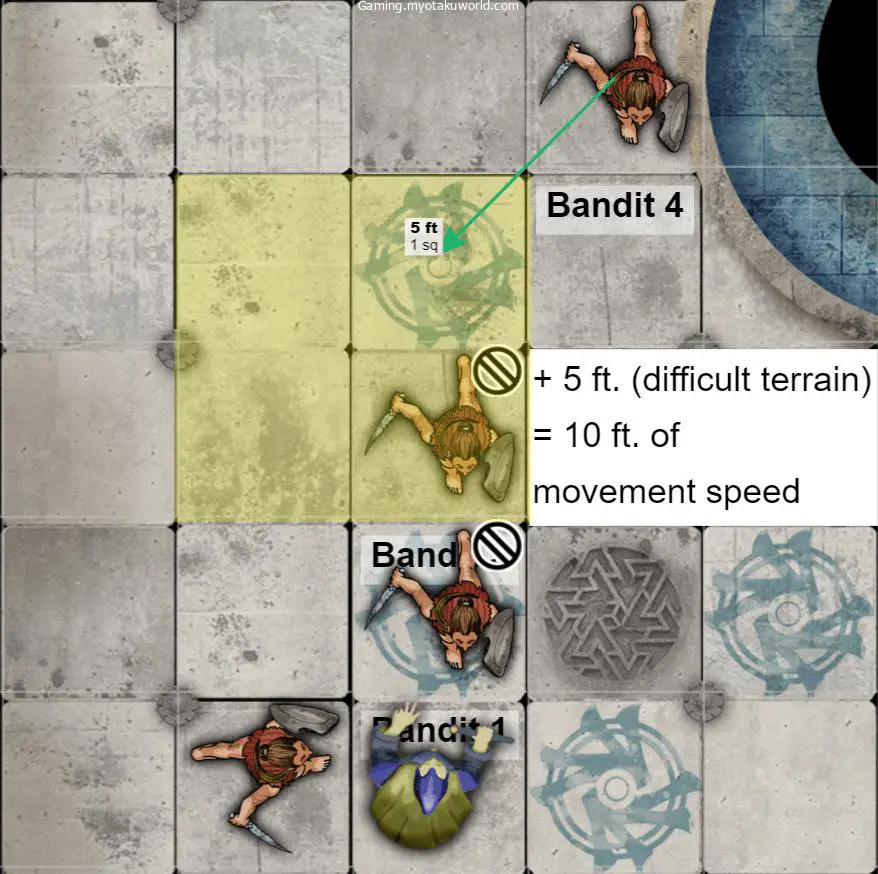
The rules of the spell say that anyone who enters the area must pass a Dexterity saving throw. If they don’t, they’ll fall flat. So, he rolls a 20-sided die and gets a 10. Bandit 4 also has a +2 Dexterity saving throw modifier, so this is how we figure out his result:
- Dexterity saving throw = d20 + Dexterity saving throw modifier
- Dexterity saving throw = 10 + 2
- Dexterity saving throw = 12
Like Bandit 3, Bandit 4’s Dexterity saving throw of 12 does not reach Marshal’s Spell Save DC of 15. Therefore, he falls prone.
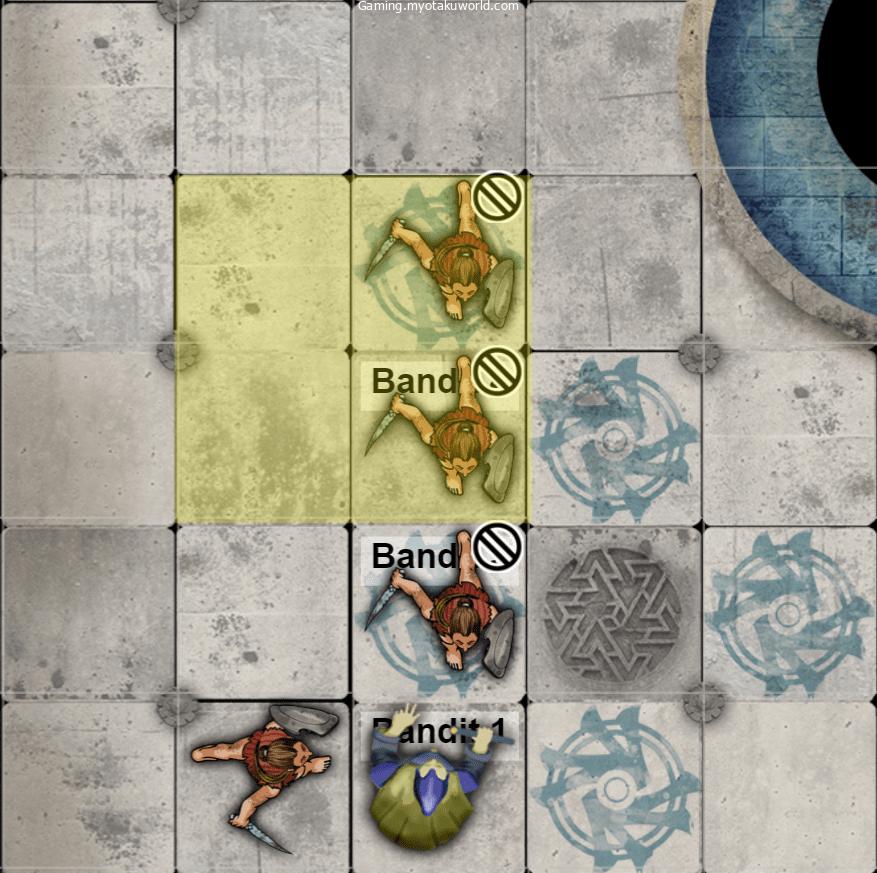
Marshal Attacks Bandit 1
Now it’s Marshal’s turn again. So, Bandits 1, 3, and 4 are all lying down, and Bandit 2 is on his left. Bandit 1 is right in front of him, so Marshal decides to use his quarterstaff to attack him.
Bandit 1 is on the ground, and Marshal is five feet away from him. This gives Marshal an advantage on his attack roll, so he rolls two d20s and picks the higher number.
He rolls a 4 and a 14, and he chooses the 14. When the right modifiers are added, Marshal’s attack roll is higher than Bandit 1’s Armor Class. This means that his attack hits.
Marshal rolls a d6 to see how much damage the quarterstaff will do and gets a 4. Then, Bandit 1 loses four HP. If Marshal was more than five feet away from Bandit 1, he would lose on his attack roll.
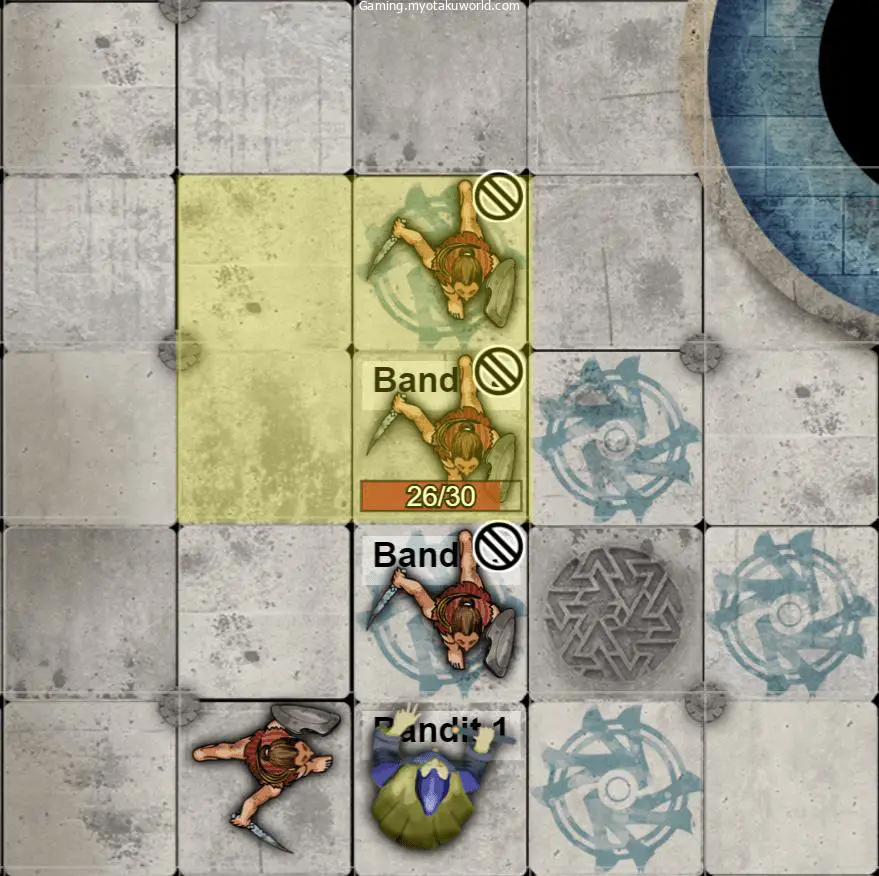
Who Can Cast Grease in D&D 5e?
The Grease spell can be used by the Artificer, the Wizard, and the Arcane Trickster Rogue and the Eldritch Knight Fighter. Sorcerers can use the Grease spell if they follow the rules set out in Tasha’s Cauldron of Everything for the class’s Extended Spell List.
Classes that Can Cast Grease in D&D 5e
With the Grease spell, only the Artificer and the Wizard can make the ground slippery. At level one, both classes have two level one spell slots, so they can learn this spell as soon as they reach that level. Here are the most important things to know about these classes, as well as their Spell Save DCs.
| Classes that can cast Grease | Class Source | Spell Save DC |
| Artificer | Tasha’s Cauldron of Everything, page 9 | 8 + your Intelligence modifier + your proficiency bonus |
| Wizard | Player’s Handbook, page 56 | 8 + your Intelligence modifier + your proficiency bonus |
The Grease spell is also on the Sorcerer’s Extended Spell List, says Tasha’s Cauldron of Everything. But it depends on your table if they let you follow this rule. So, ask your DM ahead of time. The Sorcerer’s Spell Save DC is equal to 8 + their Charisma modifier + their proficiency bonus.
Subclasses that Can Cast Grease in D&D 5e
Only the Arcane Trickster Rogue and the Eldritch Knight Fighter are able to use the Grease Spell. Here is information about their subclass source, the subclass feature that gives them access to the Grease spell, their Spell Save DC, and more.
| Subclasses that can cast Grease | Originating Class | Subclass Feature for Grease | Subclass Source | Class Source | Spell Save DC |
| Arcane Trickster | Rogue | Spellcasting | Player’s Handbook, page 97 | Player’s Handbook, page 94 | 8 + your Intelligence modifier + your proficiency bonus |
| Eldritch Knight | Fighter | Spellcasting | Player’s Handbook, page 74 | Player’s Handbook, page 70 | 8 + your Intelligence modifier + your proficiency bonus |
This spell is on the Wizard spell list, so both Spellcasting subclasses can use it. This is because their Spellcasting subclass feature gives them access to the spells on that list.
But the Arcane Trickster Rogue only learns how to use Wizard spells for enchantment and illusion. In the meantime, the Eldritch Knight Fighter learns more about the Wizard spells of evocation and abjuration.
Still, when they reach levels 3, 8, 14, and 20, they can learn one spell from another school of magic. So, they won’t be able to learn the Grease spell until they reach these levels.
Creative and Useful Ways to Use Grease in D&D 5e
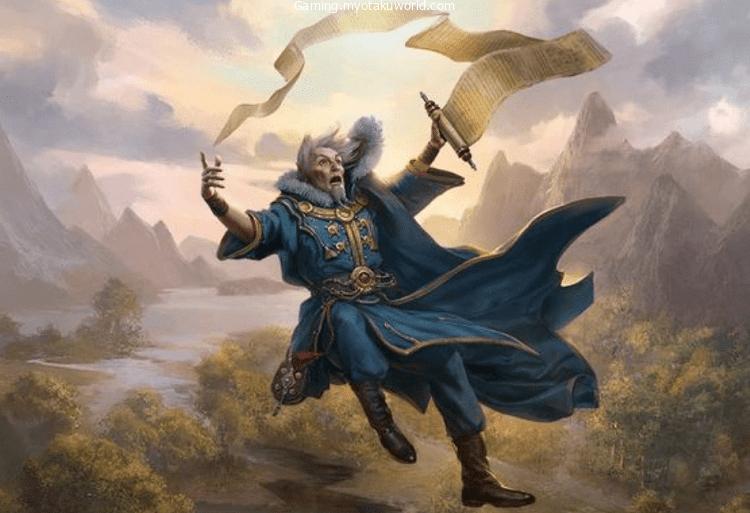
The Grease spell is very useful in many situations. You can use it to make your enemies fall and waste their movement speed. Unlike many spells, it doesn’t depend on the situation because you can use it in many different ways during battle.
Still, if you want to use the Grease spell in D&D 5e in a new and creative way, here are some great ideas I’ve come up with.
- Avoiding a flank
- Buying yourself time
- Amplifying traps
- Creating a chokepoint
Avoiding a Flank Using Grease in D&D 5e
Flanks can be very dangerous, but many players don’t pay enough attention to them. If you don’t know what a flank is, it is when enemies are both in front of and behind you at the same time.
So, you can’t run away to safety because an enemy is waiting behind you to see what you do. This strategy is used in wars and in video games like Valorant and Counter-Strike: Global Offensive.
Doesn’t it sound scary? If you want to avoid getting flanked, the Grease spell is a great way to do it. You can use Grease to block an entry point if you think that enemies coming through it could be dangerous during a battle.
But it doesn’t tell you when an enemy is nearby. Instead, it makes it harder and slower for them to move. So, you should keep looking at the door.
Buying Yourself Time Using Grease in D&D 5e
You are trying to get away from a group of guards who know you are in the mansion of a wealthy aristocrat. You find a room and go in, but when you get there, you find that it leads nowhere.
Soon, the guards will be closing in, but the rogue in your group can make a way out. But he needs some time to get it ready. How do you buy time so the guards don’t catch up with you before you can all get away?
In these situations, the Grease spell would come in handy. All you have to do is cast it and put it on the door to the room. So, if the guards try to get in, they have to go through rough terrain.
There is a chance they will fall, which is good because standing up takes half of the creature’s movement speed. Your rogue will have plenty of time by the time it needs to move an extra foot because of the terrain.
Amplifying Traps Using Grease in D&D 5e
Traps are good ways to get rid of enemies. But one problem with these traps is that sometimes enemies can get out of them easily. For example, people can easily leave a room that has been changed to shoot fire from every direction through the door.
With the right amount of flexibility, it’s easy to move a swinging axe through a Skyrim-style passageway. Now, everything has changed because of the Grease spell.
With the Grease spell, it is harder to get away from a trap. With the “Prone” condition, you can force an enemy to stay in one place for a long time. Then, the trap does what it needs to do to hurt those people.
Moving away is also hard because the rough terrain makes every step take an extra foot. You can make it hard for your enemies to move quickly by making the ground slippery.
Creating a Chokepoint Using Grease in D&D 5e

On the battlefield, there are times when you want your enemies to move to a certain spot. On the cobblestone path, there might be a trap waiting for the enemy to step on it. You can’t just tell them to do it, though.
Imagine telling someone you are fighting against that they should go here. It sounds very suspicious. Instead, you have to force them to move in different ways.
This can be taken care of by the Grease spell. By casting it, you make the ground hard enough that your enemies won’t want to cross it.
If there are two entrances and one of them is covered with slimy stuff, you would want to go to the one that looks safe. But if your enemies try to cross the area of the Grease spell, you can easily kill them, especially if they are on the ground.
FAQs
Is Grease Flammable in D&D 5e?
In D&D 5e, the slick grease that the grease spell makes is not flammable. In D&D, spells are very clear about how they work. For example, the grease spell does not say that it is flammable.
But some dms let it become flammable because it makes sense. You can change the rules, but I wouldn’t because I think that would make the spell too strong for a level one spell.
IS GREASE A SORCERER SPELL IN D&D 5E?
Yes, the grease spell can be a part of the sorcerer spell list in d&d 5e, although it depends if you abide by the rules of tasha’s cauldron of everything.
The book provides players with optional rules to play with in their games, and one of them is the extended spell list. It is a list of spells that the class can learn even if it was not a part of its spell list in the player’s handbook.
CAN YOU DISPEL GREASE IN D&D 5E?
Yes, you can dispel the grease spell’s effects in d&d 5e by using dispel magic, a level three abjuration spell. According to the spell’s rules, its caster can choose a magical effect and make it automatically disappear if the spell causing it is level three or lower.
Since grease is a level one spell, dispel magic can dispel the slippery substance on the ground.
WHAT ITEM CASTS GREASE IN D&D 5E?
The oil of slipperiness, as detailed in the dungeon master’s guide on page 184, is an uncommon potion the players can use to make the ground slippery.
To do so, you pour the contents of the potion onto the ground to cover a 10-foot square of it with grease. Thus, you effectively duplicated the effects of the grease spell. What’s better is that the grease from the oil of slipperiness can last for eight hours.:
